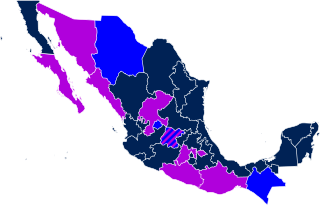
The United Mexican States is a federal republic composed of 32 federal entities: 31 states and Mexico City, an autonomous entity. According to the Constitution of 1917, the states of the federation are free and sovereign in all matters concerning their internal affairs. Each state has its own congress and constitution.

The Congress of the Union, formally known as the General Congress of the United Mexican States, is the legislature of the federal government of Mexico consisting of two chambers: the Senate of the Republic and the Chamber of Deputies. Its 628 members meet in Mexico City.

Chiapas is a state in Southwest Mexico. According to the 2020 Mexican census, it has the eighth largest population of all states with 5,543,828 inhabitants and the 10th largest by land area spanning 73,560.47 square kilometres (28,401.86 sq mi). Chiapas is officially divided into 124 municipalities, although the establishment of municipal authorities in Belisario Domínguez was suspended in 2015 pending the resolution of a territorial dispute between Chiapas and the neighbouring state of Oaxaca. In 2021, the Mexican Supreme Court resolved this dispute in Oaxaca's favour, and annulled the 2011 decree that had created Belisario Domínguez.

Colima is a state in West Mexico that is divided into ten municipalities. According to the 2020 Mexican census, it has the smallest population of all Mexico's states with 731,391 inhabitants, and is the fifth smallest by land area spanning 5,801.75 square kilometres (2,240.07 sq mi).

The Congress of the State of Nuevo León is the unicameral legislature of the government of the Mexican state of Nuevo León. Each three-year legislative term consists of 42 deputies, with 26 elected through relative majority and 16 through proportional representation.

Municipalities are the second-level administrative divisions of Mexico, where the first-level administrative division is the state. They should not be confused with cities or towns that may share the same name as they are distinct entities and do not share geographical boundaries. As of January 2021, there are 2,454 municipalities in Mexico, excluding the 16 boroughs of Mexico City. If all 16 boroughs of Mexico City are counted, the total of municipalities will be 2,470.

Lesbian, gay, bisexual, and transgender (LGBT) rights in Mexico expanded in the 21st century, keeping with worldwide legal trends. The intellectual influence of the French Revolution and the brief French occupation of Mexico (1862–67) resulted in the adoption of the Napoleonic Code, which decriminalized same-sex sexual acts in 1871. Laws against public immorality or indecency, however, have been used to prosecute persons who engage in them.

Same-sex marriage is legally recognized and performed throughout Mexico since 31 December 2022. On 10 August 2010 the Supreme Court of Justice of the Nation ruled that same-sex marriages performed anywhere within Mexico must be recognized by the 31 states without exception, and fundamental spousal rights except for adoption have also applied to same-sex couples across the country. Mexico was the fifth country in North America and the 33rd worldwide to allow same-sex couples to marry nationwide.

The following is an alphabetical index topics related to the Mexico.
Eufrosina Cruz Mendoza is a Zapotec activist for gender equality and the rights of indigenous women and communities. In November 2010 she became the first indigenous woman in Oaxacan politics, assuming the position of deputy of the National Action Party and president of the board of the local congress. In December of the same year Eufrosina was appointed as coordinator of indigenous affairs of the National Executive Committee of the PAN. She is also the founder and director of the QUIEGO Asociación Civil, which promotes gender equality in Oaxaca.
Most Mexican states do not have an official flag. For these states, a de facto flag is used for civil and state purposes. State flags of Mexico have a 4:7 ratio and typically consist of a white background charged with the state's coat of arms.
Same-sex marriage has been legal in Baja California Sur since 29 June 2019. On 27 June, the state Congress passed a bill opening marriage to same-sex couples. It was published in the official state gazette on 28 June and took effect the following day, legalizing same-sex marriage in Baja California Sur.
Same-sex marriage has been legal in Tabasco since 27 October 2022. A bill to legalise same-sex marriage was passed by the Congress of Tabasco on 19 October 2022. It was signed by Governor Carlos Manuel Merino Campos, and published in the official state journal on 26 October, taking effect the next day. Tabasco was the fourth-to-last state in Mexico to legalize same-sex marriage.

The Congress of Aguascalientes or by your full name Congress of the Free and Sovereign State of Aguascalientes is the depository body of the legislative power of the Mexican state of Aguascalientes, It is a unicameral assembly made up of twenty-seven deputies, of whom eighteen are elected by relative majority and nine by proportional representation.

The Legislature of the State of Querétaro is the unicameral legislature of the Mexican State of Querétaro, invested with the State's legislative power. Unlike in other States of Mexico, where the deliberative body is called "Congress", Querétaro's Constitution states that the name of the State's deliberative body is "Legislature".
Pedro César Acosta Palomino was a Mexican politician who was a member of the National Action Party. He served as a plurinominal federal deputy and municipal president of Chihuahua in 1986.
Ñuu Savi is a municipality in the Mexican state of Guerrero. It is located 85 kilometres (53 mi) southeast of the state capital of Chilpancingo. Its creation from the municipality of Ayutla de los Libres was approved in 2021 and went into force on 21 May 2022.











